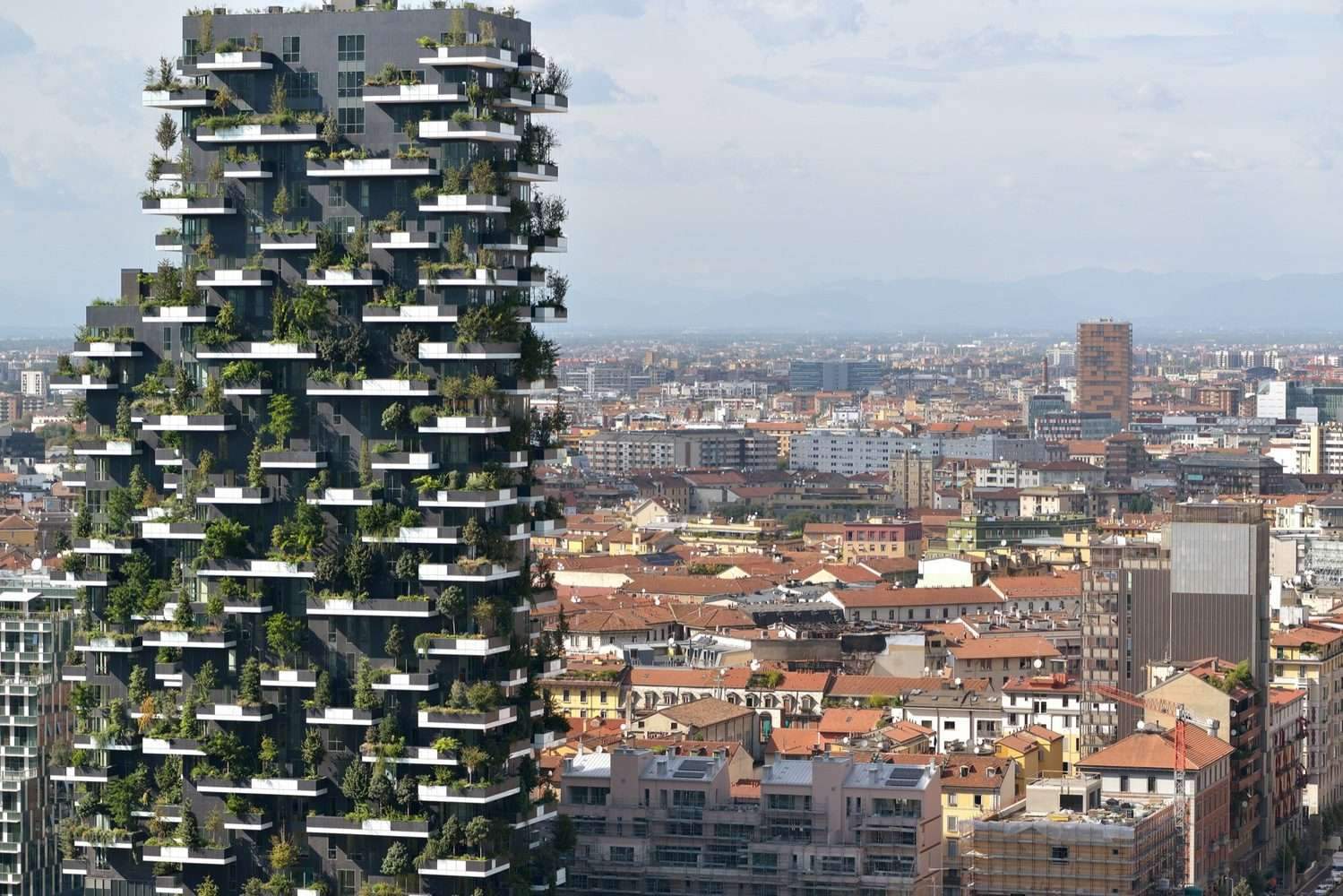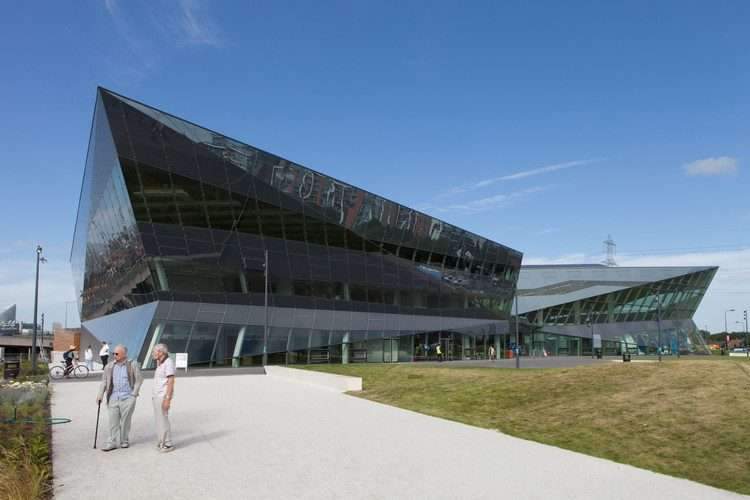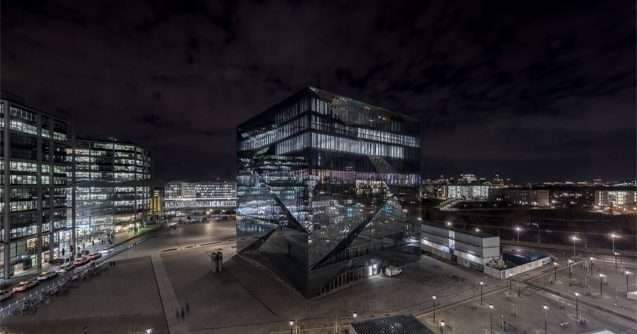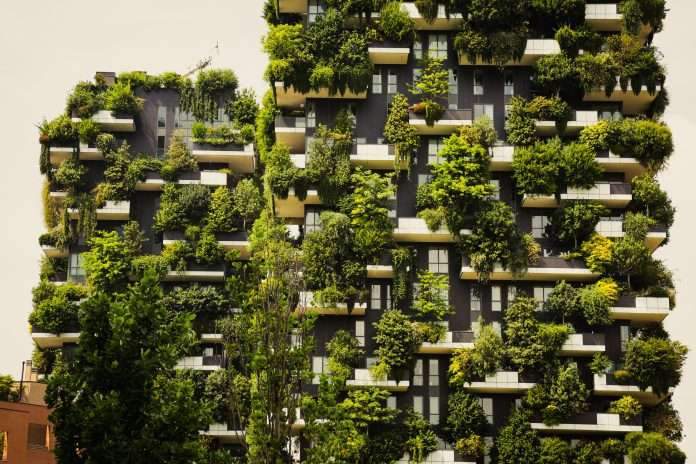10 sustainable buildings around the world,
In an age when sustainability is an important criterion for forward-thinking buildings,
it is inspiring to see how far architecture and design have come in striving to create a greener approach to building.
From Amsterdam to Tokyo, the following ten buildings are some of the most sustainable structures in the world,
showcasing the power of design to create positive environmental change.
The Edge Amsterdam
Located in the heart of Amsterdam, The Edge is a model of sustainability and innovation.
The building was constructed by PLP Architecture,
a firm that specializes in creating modern workspaces with strong environmental principles.
Thanks to its unique design, The Edge has earned the title of one of the most sustainable buildings on the planet.
The Edge has been designed to emphasize energy efficiency, conservation and renewable energy sources.
Its structural core contains heat-absorbing and energy-producing materials such as wood and concrete.
This allows natural heating and cooling to occur within the building itself.
In addition, it uses an innovative sun shading system that helps reduce glare while contributing to energy conservation goals.
Moreover, The Edge is equipped with several eco-friendly features, such as rooftop solar panels,
rainwater harvesting systems, and electric vehicle charging points to further reduce carbon emissions.
Its green roof also acts as an insulating layer while providing additional spaces for vegetation to grow.
Those looking to work or visit the building itself will be happy to know that it also contains many other facilities that promote sustainability, such as an indoor bike park, swimming pool and garden terrace.
All of these features explain why The Edge is one of the most sustainable buildings today.

Bosco Vertical Milan
The Bosco Verticale, or Vertical Forest, in Milan, Italy, is an example of a revolutionary building that pushes the boundaries of sustainable architecture.
This building consists of two residential towers with a length of 110 and 76 meters,
and contains 9,000 trees, 13,000 shrubs, and 5,000 plants covering it.
It is designed to produce oxygen, reduce pollution, and create habitats for local birds and insects.
The project is collaboration between Stefano Boeri Architetti, an architecture firm,
and the City of Milan, with the goal of creating a sustainable and livable urban environment.
The towers are made of natural materials such as cement, aluminum and glass, which provide insulation and reduce energy costs.
The two towers are surrounded by a green area of 15,000 square meters, which increases the biodiversity of the building.
Bosco Verticale effectively responds to the complex challenges of climate change,
using natural elements to reduce energy consumption, reduce air pollution and promote green public spaces.
This building is a great example of sustainable architecture and is used as a model for other cities looking to build environmentally friendly structures.

One Central Park Sydney
Located in the heart of Sydney, Australia, One Central Park is a stunning example of what can be achieved when sustainability and beauty come together.
The two towers, designed by architect Jean Nouvel, are topped with a sky garden.
This sky garden consists of a range of green walls planted with native Australian species,
providing a lush and ecologically diverse environment.
The development includes several sustainability initiatives,
such as a range of photovoltaic panels that generate a large amount of renewable energy,
water recycling and storage systems, and smart building technology that helps regulate energy use.
In addition, the project features many green features, such as the sky garden and green walls,
which contribute to building habitats and biodiversity.
The building is a valuable example of how sustainable and innovative design can be both aesthetically pleasing and environmentally beneficial.
It is also a great example of how a building project can be sensitive to its surrounding environment, creating a green,
vibrant and inspiring space.
As a result, One Central Park has become a leading example of sustainable building design in Australia and abroad.

Crystal London
Located at Royal Victoria Dock in London, The Crystal is an award-winning,
iconic sustainable building that serves as a model for modern, renewable energy technology.
Considered a hub for sustainability, this building prioritizes environmentally friendly practices and services,
and seeks to inspire sustainable transformation around the world.
Designed by renowned architectural firm Grimshaw,
Crystal was built in 2012 and is powered by a range of renewable energy sources, including solar, wind and geothermal.
The building has a zero carbon footprint and contains a range of energy saving and power generation features,
including an electric vehicle charging station, wind turbines, and photovoltaic panels that generate electricity from the sun.
The building’s sustainability is further demonstrated by its expansive green roof,
which is insulated, keeping it cooler in the summer and warmer in the winter while providing a habitat for birds and other wildlife.
Inside the building, occupancy sensors detect motion and adjust lighting accordingly to increase energy efficiency.
Water-saving showers, toilets, and other fixtures contribute to the building’s sustainability efforts.
In addition to the sustainability achieved through energy efficiency,
The Crystal is committed to providing educational and community outreach to help spread the message of sustainability.
Through sustainability literacy programs, The Crystal offers workshops,
seminars and other events to inspire others to reduce their carbon footprints and lead more sustainable lifestyles.
Crystal is a shining beacon of sustainability and an example of the vast potential of renewable energy.
Through its commitment to sustainability and pioneering use of renewable energy sources,
The Crystal is a prime example of what can be achieved when we prioritize sustainability.

KPMG Headquarters Amsterdam
The KPMG headquarters building in Amsterdam, the Netherlands is one of the most sustainable buildings around the world.
It features an innovative design that combines sustainability and comfort for its occupants.
It was designed by the famous architecture firm Mecanoo International as an office building for KPMG Netherlands.
The building uses the Dutch climate to remain energy efficient and environmentally friendly.
Natural ventilation, passive cooling and natural light play important roles in reducing energy use and creating a pleasant environment.
In addition, the building uses renewable energy to meet its energy needs.
Particular attention has been given to the building envelope, which is well insulated with high quality materials.
The building’s curved façade made of glass panels tinted in shades of blue gives the building a striking yet elegant appearance.
The curved façade also helps reduce wind pressure on the building and reduce energy consumption.
Furthermore, the building features rooftop solar panels, a rainwater harvesting system, and a gray water recycling system.
All of these features help reduce water usage and energy consumption.
The building is also designed according to BREEAM sustainability standards, making it more environmentally friendly.
This iconic building is among the top 10 most sustainable buildings in the world and is considered a paradigm for green building design.
It is a testament to the environmental and economic benefits of sustainable building design
and a great example of how green technologies can be used to build a sustainable future.
Masdar City Abu Dhabi
Masdar City, located in Abu Dhabi, is a project committed to building a city with the lowest environmental footprint.
This city of the future has been a concept since 2006 and first appeared in 2008. By 2050,
Masdar City will be a zero-carbon, zero-waste city entirely powered by renewable energy.
It is an excellent example of how sustainable architecture can create a better future.
Buildings in Masdar City are designed to maximize energy efficiency, minimize carbon emissions,
and capture and reuse renewable energy.
All of its buildings are built on energy conservation, renewable energy, water conservation, waste management,
and sustainable materials.
Some of the innovative features of the buildings at Masdar City include solar panels, wind turbines,
LED lighting, photovoltaic windows and temperature-controlled facade systems.
In addition, each building is designed to maximize natural light and minimize the need for air conditioning, thus reducing the city’s electricity consumption.
Moreover, wastewater is reused for cooling and irrigation, and recycled materials are used to construct buildings.
Masdar City also has an electrified public transportation system with minimal emissions.
By incorporating these sustainable technologies,
Masdar City is an example of how cities can adapt to become green and reduce carbon emissions.

Solar City San Francisco Tower
Located in San Francisco, the SolarCity Tower is a modern and sustainable building that offers visitors a unique experience.
Built in 2014, the building is the first net zero commercial operation in the United States and is designed to produce more energy than it consumes.
The exterior consists of an array of solar panels that generate electrons from the sun,
which are then transmitted to the grid to compensate for the energy used by the building.
In addition, the building was created to emphasize energy efficiency, as it features double-glazed windows,
highly efficient HVAC systems, and more to reduce energy use.
To further its sustainability efforts, the SolarCity Tower uses free cooling technology,
utilizing the natural temperature within the building instead of operating standard air conditioning units.

This not only reduces electricity usage, but also makes the building more comfortable.
In addition, the building is continuously monitored, and energy usage is adjusted to ensure it runs as efficiently as possible.
The SolarCity Tower is also a great example of how sustainable buildings can be created using the latest technology.
Through the use of advanced energy-efficient systems,
the Solar City Tower has become an example of what is possible in terms of sustainable design.

Cube Berlin
Cube, a landmark urban project located in Berlin, Germany, ranks eighth in the list of the world’s most sustainable buildings.
This unique building has been recognized for its energy efficient design, which uses renewable energy sources to power the complex.
It is also an example of a building that achieves a carbon-neutral footprint, meaning that it does not emit carbon dioxide.
Cube’s design is a blend of modern and sustainable architecture.
Exterior consists of a three storey steel and glass facade with a green roof.
The building contains various sustainable systems and technologies to reduce energy consumption and emissions.
The Cube’s heating and cooling systems are based on a combination of ground heat pumps, solar thermal collectors and geothermal energy.
In addition, rainwater is harvested on site and reused in the building, while LED lighting and energy-efficient windows help reduce energy costs.
Cube is a great example of how buildings can be built more sustainably and efficiently.
It is a model for other cities around the world to create more environmentally friendly and energy efficient developments.
The Cube is a great example of how buildings can be designed to reduce their negative environmental impact and create a better future for the planet.
The Village of the Baobab Senegal
Located in the heart of Senegal, Baobab Village is an innovative and sustainable building project that seeks to showcase how modern building technology can be combined with traditional African architectural designs.
Founded by the architectural team of Alejandro and Nicolás Arcuenejo,
it is an example of how sustainable building initiatives can be implemented around the world.
Energy efficiency and environmental awareness are key principles of the project, as solar energy provides the main source of power generation in the village.
While all buildings are constructed using locally sourced materials and using traditional African construction methods.
The building designs also consider the area’s environment, taking into account both existing trees and plants and the local wildlife.
To ensure the project’s long-term sustainability, special attention was paid to the reuse and recycling of materials and resources.
Rainwater harvesting and organic waste recycling systems are also used to reduce the energy and resources needed to build and maintain the village.
The project has proven to be very successful, as the village provides much needed employment and housing opportunities for the surrounding residents.
It also provided many educational opportunities and workshops for local youth,
helping to create a more sustainable and prosperous future.

Akros Fukuoka International Prefectural Hall Japan
Akros Fukuoka International District Hall in Fukuoka, Japan ranks as the 10th most sustainable building worldwide.
Located right in the heart of the city, the building provides a stunning visual presence,
as its design features a canopy of greenery across its entire facade.
Constructed in 1995 in collaboration with Arata Isozaki, the building consists of 15 floors of offices,
a conference hall, a gym and a shopping mall, making it a sustainable all-in-one building.
The building has been designed sustainably and energy-efficiently, using natural light, natural ventilation,
and an advanced renewable energy system.
The building is one of the first buildings in the world to receive a 3-star rating from the Japan Green Building Council.
It is an example of the Japanese government’s commitment to the environment and the promotion of sustainable buildings.
The building also features a rainwater harvesting and recycling system, which can store up to 10,000 tons of water during the rainy season.
In addition, the building is also equipped with a state-of-the-art air conditioning system that uses free cooling to reduce energy consumption and reduce the use of artificial cooling systems.
All in all, Akros Fukuoka International Prefecture Hall is a great example of how to design and build sustainably to meet environmental and economic goals.
The building is also a prime example of sustainability in action through the use of many renewable energy sources,
benefiting from natural lighting and ventilation, and reducing energy consumption.
For more architectural news


 العربية
العربية